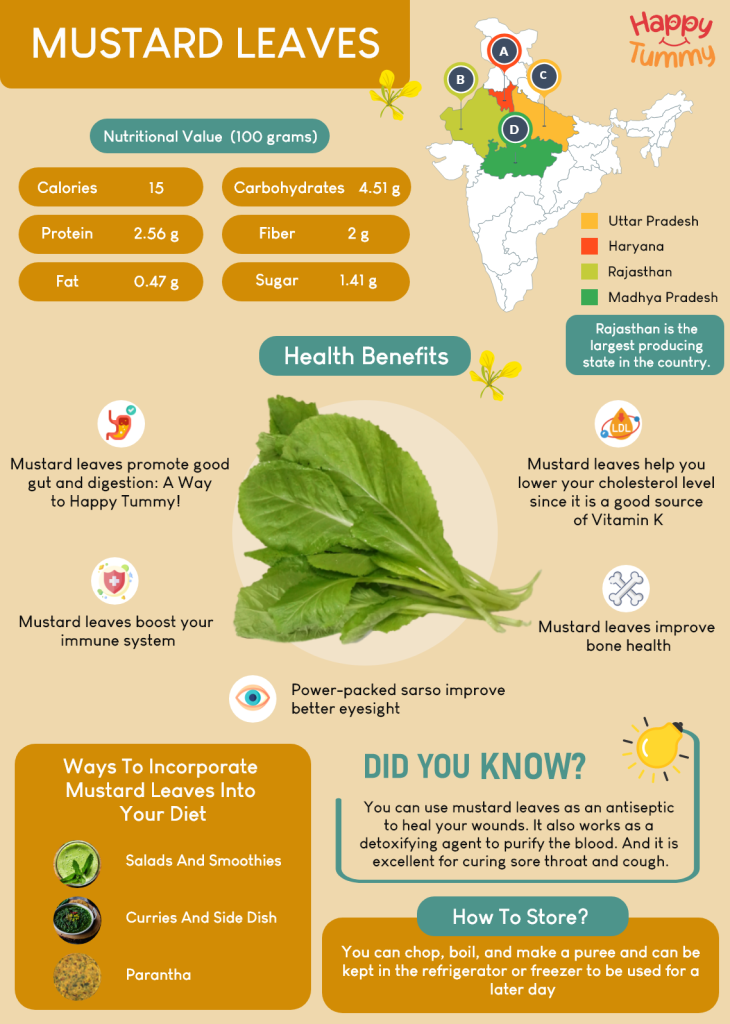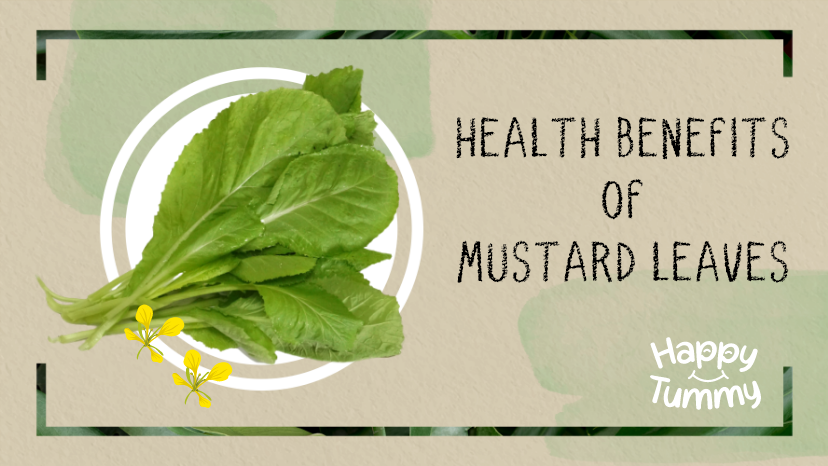Table of Contents
The winter season in India is dedicated to green leafy vegetables. I clearly remember my childhood when my mother used to force-feed me green vegetables since they are full of nutrients and are great for our bodies.
Now that I am a little girl’s mother, I realize how vital eating vegetables is. One such and my family favorite is mustard leaves, or as we all know, sarso in India.
Our winter favorite sarso plant is more than just the leaves. It produces yellowish little seeds that are used to make mustard or rai, as we call in Hindi. The Sarso plant is why we get sarso oil used in various cuisines and dishes in India. Today, check out some interesting facts and benefits of mustard leaves.
Do you know?
You can use mustard leaves as an antiseptic to heal your wounds. It also works as a detoxifying agent to purify the blood. And it is excellent for curing sore throat and cough.
You will also be amazed that the fantastic sarso leaves have better Vitamin A than spinach and more Vitamin C than oranges. So, what are you waiting for?
Eat them raw, boiled, stir-fried, or steamed, and add mustard greens to your diet.
History Of Mustard Leaves
It is one of the oldest plants, and you will be surprised to know that it has its mention in stories of the Bible. Mustard leaves have been used there to promote the potential to grow strong and wide. It is also believed that the first mustard seed was found way back in the Stone Age era.
Also, there are many stories about it being used in the Egyptian and Roman times to flavor their food with it. From there, it reached Europe and India in the 16th century when Vasco De Gama came.
In India, these are grown in Haryana, Rajasthan, Uttar Pradesh, and Madhya Pradesh. Rajasthan is the largest producing state in the country.
Health Benefits Of Mustard Leaves

Besides being rich in Vitamins, mustard leaves possess more benefits than you can imagine. Let’s see some of them for you:
1. Mustard for Good Digestion: A Way to Happy Tummy!
My mother always told me to eat fiber-rich food for a happy gut and stomach. Sarso is one such ingredient that can promote good gut and digestion and help you with smooth bowel movements.
So, address your constipation problems with this excellent natural remedy, and please your tummy with excellent fibre and nutrition!
2. Mustard Leaves for Immune System
If your family has a history of low immunity, it is time to add mustard to their diet. You may not know that just one cup (1) of mustard provides more than one-third of the daily Vitamin C requirement.
And you need this vitamin in good quantity to boost your immune system. Less of this vitamin can weaken your immune and make you fall sick easily.
3. Mustard Leaves for Lower Cholesterol
High cholesterol is becoming a problem with many these days, and you can blame the culture of fast food or unhygienic food. Eating cooked sarso can help you lower your cholesterol level since it is a good source of Vitamin K (2).
You can even cook sarso ka saag and try it with missi roti or multi grain roti to enhance the nutritional benefits of your meal. Aashirvaad multigrain atta is the perfect choice if you want to steer clear of the burden of mixing different flours at home.
You can eat rotis made with this atta and pair it with saag for an ultimate lunch.
4. Mustard Leaves for Bone Health
Mustard leaves are believed to have properties and vitamins that may help improve bone strength. The vitamins present in it can prevent many bone problems and eventually help harden the bones.
So, next time don’t force your kids to drink milk if they don’t like it; instead, offer them dishes made of sarso, which will do the same thing.
5. Mustard Leaves for Eye Health
Who would have imagined eating mustard could lead to better eyesight? But that does not change the fact. These power-packed sarso leaves have antioxidants (3) that help to improve eyesight.
So, if you want to have better eyesight when you age or avoid your age-related vision problem, you know what you need to eat. And trust me, sarso is a delicious ingredient to add to your diet.
Nutritional Value Per Serving Of Mustard Leaves
One cup serving of 100 grams (4) contains the below nutrients:
| Calories | 15 |
| Protein | 2.56 grams |
| Fat | 0.47 grams |
| Carbohydrates | 4.51 grams |
| Fiber | 2 grams |
| Sugar | 1.41 grams |
Ways To Incorporate Mustard Leaves Into Your Diet
You may have heard of the Punjabi way of cooking sarso and eating it with Makki ki roti. But this time, try to be different and innovative and make something unique from this excellent ingredient that is fibrous and filled with goodness.
Here are a few ways you can try to incorporate mustard leaves into your diet:
1. Salads And Smoothies
Like spinach, you can wash, dry, and chop the sarso leaves and add them to your green salad for a healthy diet.
Try picking fresh leaves that will be less bitter; else, you can toss them in some oil and then add them to your salad.
Some people enjoy smoothies made of greens; you can even add these leaves to make it a power-packed one. Drinking smoothies help in keeping your gut balanced and happy. So green smoothies equal a happy tummy.
2. Curries And Side Dish
Everyone knows about the famous winter delicacy, saag, but you may not know that sarso tastes good in combination with various dals. Like you make dal palak, you can try to make sarso dal.
You can use moong, masoor, or even toor dal for cooking with sarso.
Additionally, you can finely chop the sarso and sauté in some oil, garlic, salt, and pepper to serve with baked or grilled chicken or protein of your choice.
3. Parantha
Not many have heard about a sarso’s paratha, but it does taste delicious.
Wash your sarso leaves appropriately to remove all dirt, then finely chop them. Heat some oil, and sauté onions and mustard leaves until dry; add salt and red chili.
Let the mixture cool, and add Aashirvaad multigrain atta to make a rough dough. Roll out and make paratha like usual.
How To Select Mustard Leaves?
You will see sarso in India between Mid-Octobers till Late March. You try and buy the ones that are fresh and young and have crispy and dark color leaves. Avoid leaves that are discolored, yellow, or have spots or holes.
Even if you find sarso in the summer months, it will have a different taste and may not even be great for cooking. So, try and eat this seasonal vegetable in its season to maximize its benefits.
How To Store Mustard Leaves?
Sarso leaves are great and should be eaten immediately to maximize all their nutritional properties. But if you can’t consume them on the same day, you can wash them properly, chop them, and store them in an air-tight container.
But remember to use it within 2-3 days; otherwise, it will dry out and not be useful.
Additionally, you can chop, boil, and make a puree. This puree can be kept in the refrigerator or freezer to be used for a later day.
It will be good in the refrigerator for 4-5 days and in the freezer for up to 1 month.
How To Clean Mustard Leaves?
Cleaning these leaves is very important and necessary since they can have a lot of soil, sand, surface dust, and other chemicals used for growing.
The most suitable way to clean them is by running them under clean water until you find no more dust or sand in your hands while rubbing and washing them.
So, Surprised at the Benefits? You Should Not Be!
Mustard leaves are versatile vegetables with bitter and peppery flavor if eaten raw. It is usually preferred to be eaten cooked in one of the abovementioned forms.
It is also one of the most nutritious plants with many minerals and other valuable properties, so incorporating it into your diet will also have benefits.
FAQs
Yes, it is a nutritious plant available during the cold season in India. You can cook it, add it to your family’s diet plan, and offer them the best health.
Although the plant is safe to consume, people with known stones problem should try and avoid this ingredient. It is because a substance in vegetables belonging to the Brassica family (a family of cabbage and sarso) can lead to the crystallization of stones.
Both are green leafy vegetables that have their goodness of minerals and vitamins. Sarso has a better Vitamin C content than spinach, which has more iron content.
Sarso leaves are a great source of fiber and antioxidants in nature. Fibrous foods are always considered excellent weight loss alternatives.
Since these are naturally fibrous, eating too much raw or cooked sarso leaves can result in gas and bloating. If something like this happens, it is better to consult your doctor.
It is believed that green leafy vegetables such as kale, lettuce, and sarso have some sedative (an element that helps in sleeping) properties that can promote a night of good sleep.
















